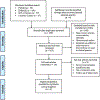Safety and sedation-associated adverse event reporting among patients undergoing endoscopic cholangiopancreatography: a comparative systematic review and meta-analysis
- PMID: 33966121
- PMCID: PMC8852850
- DOI: 10.1007/s00464-020-08210-2
Safety and sedation-associated adverse event reporting among patients undergoing endoscopic cholangiopancreatography: a comparative systematic review and meta-analysis
Abstract
Background and aim: There is wide variation in choice of sedation and airway management for endoscopic retrograde cholangiopancreatography (ERCP). The aim of this study was to perform a systematic review and meta-analysis to investigate safety outcomes of deep sedation with monitored anesthesia care (MAC) versus general endotracheal anesthesia (GETA).
Methods: Individualized search strategies were performed in accordance with PRISMA and MOOSE guidelines. This meta-analysis was performed by calculating pooled proportions using random effects models. Measured outcomes included procedure success, all-cause and anesthesia-associated adverse events, and post-procedure recovery time. Heterogeneity was assessed with I2 statistics and publication bias by funnel plot and Egger regression testing.
Results: Five studies (MAC: n = 1284 vs GETA: n = 615) were included. Patients in the GETA group were younger, had higher body mass index (BMI), and higher mean ASA scores (all P < 0.001) with no difference in Mallampati scores (P = 0.923). Procedure success, all-cause adverse events, and anesthesia-associated events were similar between groups [OR 1.16 (95% CI 0.51-2.64); OR 1.16 (95% CI 0.29-4.70); OR 1.33 (95% CI 0.27-6.49), respectively]. MAC resulted in fewer hypotensive episodes [OR 0.32 (95% CI 0.12-0.87], increased hypoxemic events [OR 5.61 (95% CI 1.54-20.37)], and no difference in cardiac arrhythmias [OR 0.48 (95% CI 0.13-1.78)]. Procedure time was decreased for MAC [standard difference - 0.39 (95% CI - 0.78-0.00)] with no difference in recovery time [standard difference - 0.48 (95% CI - 1.04-0.07)].
Conclusions: This study suggests MAC may be a safe alternative to GETA for ERCP; however, MAC may not be appropriate in all patients given an increased risk of hypoxemia.
Keywords: Adverse events; Anesthesia; Endoscopic retrograde cholangiopancreatography (ERCP); Endoscopy; Sedation.
© 2021. The Author(s), under exclusive licence to Springer Science+Business Media, LLC, part of Springer Nature.
Conflict of interest statement
Potential Conflicts of Interest:
Thomas R. McCarty has no conflicts to disclose.
Kelly E. Hathorn has no conflicts to disclose.
David W. Creighton has no conflicts to disclose.
Mohd Amer AlSamma has no conflicts to disclose.
Figures




References
-
- Sethi S, Sethi N, Wadhwa V, Garud S, Brown A. A meta-analysis on the role of rectal diclofenac and indomethacin in the prevention of post-endoscopic retrograde cholangiopancreatography pancreatitis. Pancreas 2014;43:190–7. - PubMed
-
- Buxbaum J, Roth N, Motamedi N, et al. Anesthetist-Directed Sedation Favors Success of Advanced Endoscopic Procedures. Am J Gastroenterol 2017;112:290–6. - PubMed
-
- Gross JB, Bailey PL, Connis RT, et al. Practice guidelines for sedation and analgesia by non- anesthesiologists. Anesthesiology 2002;96:1004–17. - PubMed
-
- Cohen LB, Ladas SD, Vargo JJ, et al. Sedation in digestive endoscopy: the Athens international position statements. Aliment Pharmacol Ther 2010;32:425–42. - PubMed
Publication types
MeSH terms
Grants and funding
LinkOut - more resources
Full Text Sources
Other Literature Sources
Medical

